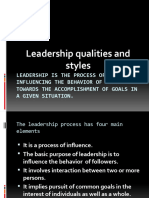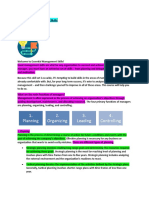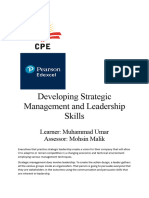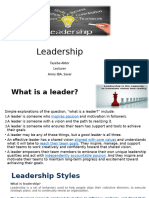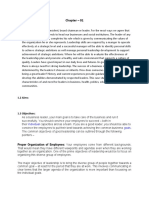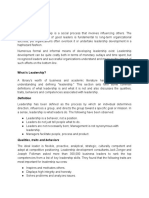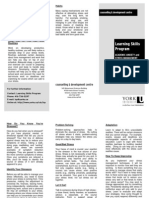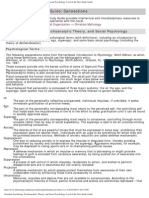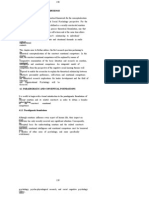Leadership Styles: Assignment 1
Leadership Styles: Assignment 1
Uploaded by
srahmed176Copyright:
Available Formats
Leadership Styles: Assignment 1
Leadership Styles: Assignment 1
Uploaded by
srahmed176Original Title
Copyright
Available Formats
Share this document
Did you find this document useful?
Is this content inappropriate?
Copyright:
Available Formats
Leadership Styles: Assignment 1
Leadership Styles: Assignment 1
Uploaded by
srahmed176Copyright:
Available Formats
PRESTON UNIVERSITY LAHORE CAMPUS NEW GARDEN TOWN
Leadership Styles
Assi!"e!t #
Javeria Mansoor
27/7/2011
Reg. No:1652-410025
Presented to : Sir Sohail !ra"
$%esti&!' Explain different Leadership Styles with examples?
A!s(er' Behavioral Leadership is a study of the actions, or behaviors,
that define a leadership style. This theoretical approach to understanding leaders creates
categories of styles. Since behavioral leadership places emphasis on the actions of the
leader.
Behavior Emotional !eelings " #ctions
Leadership style
Leadership style is the relatively consistent pattern of behavior that characteri$es a leader. These
styles and their impact can help you develop your own, personal leadership style and help
you become a more effective leader. %ost classifications of leadership style are based on
the dimensions of consideration and initiating structure.
Leadership Theories
&esearchers have developed a number of leadership theories over the years. These fall into five
main groups'
(. )articipative
*. #utocratic
+. Leadership ,rid
-. Entrepreneurial
.. ,ender differences in leadership styles
/. 0harismatic leadership
1. Tas234riented leadership
5. Transactional Leadership
6. Transformational Leadership
(7. Bureaucratic Leadership
1 Parti#i$ative leadershi$ st%les
)articipative leadership theories suggest that the ideal leadership style is one that ta2es the input
of others into account. These leaders encourage participation and contributions from group
members and help group members feel more relevant and committed to the decision3ma2ing
process. 8n participative theories, however, the leader retains the right to allow the input of
others. )articipative leadership styles can be divided into three subtypes'
0onsultative leaders
0onsensus leaders
9emocratic leaders
Consultative leaders
0onsultative leaders confer with group members before ma2ing a decision but they retain the
final authority to ma2e decisions.
Consensus leaders
0onsensus leaders try for consensus. They encourage group discussion about an issue and then
ma2e a decision that reflects general agreement and support.
Democratic leaders
9emocratic leaders confer final authority on the group. They function as collectors of group
opinion and ta2e a vote before ma2ing a decision.
2 &'to#rati# leadershi$
#utocratic leadership is an extreme form of transactional leadership, where leaders have absolute
power over their wor2ers or team. Staff and team members have little opportunity to ma2e
suggestions, even if these would be in the team:s or the organi$ation:s best interest.
%ost people tend to resent being treated li2e this. Therefore, autocratic leadership often leads to
high levels of absenteeism and staff turnover. ;owever, for some routine and uns2illed <obs, the
style can remain effective because the advantages of control may outweigh the disadvantages.
#utocratic leadership is a classical leadership style with the following characteristics'
(. %anager see2s to ma2e as many decisions as possible
*. %anager see2s to have the most authority and control in decision ma2ing
+. %anager see2s to retain responsibility rather than utili$e complete delegation
-. 0onsultation with other colleagues in minimal and decision ma2ing becomes a solitary
process
( )eadershi$ *rid St%les:
Leadership Grid - a simple assessment tool for leaders
Leadership grid was first given shape by Bla2e and %outon in (6/7s.
Leadership from the perspective of style approach
Leadership style has always fascinated researchers. &esearchers studying style approach have
broadly based their thin2ing on two types of leadership behavior = tas2 orientation or production
orientation and relationship orientation or employee orientation. Tas2 behavior or production
orientation is about leaders facilitate and reinforce achievement of a given tas2. This behavior
includes acts such as organi$ing, structuring and scheduling wor2, clarifying roles and
responsibilities, attention to policy decisions, processes, product development and results.
&elationship orientation or employee orientation is about leaders ma2ing subordinates feel
comfortable with themselves and the <ob, building trust, commitment and respect in the teams,
emphasi$ing human relations and providing good wor2ing conditions.
Blake & Moutons Leadership Grid
Leadership grid explains how leaders help organi$ations to achieve to achieve their ob<ectives
through the factors of concern for production or results >tas2 behavior? and concern for people
>relationship behavior?. The grid consists of two axes = @3axis representing concern for
production while A3axis representing concern for people on a scale 6 points. ( represents
minimum concern and 6 the maximum.
Authority Compliance Manaement or task manaement !"#$%
Leaders who fall in this category heavily emphasi$e results with minimum concern for people.
They consider people merely as a means to achieve desired results. The leader is often
characteri$ed as controlling, overpowering, over driving and coercive.
Country clu& manaement !$#"%
Leaders falling in this category are those who are concerned more welfare and personal needs of
people and lac2 the focus on tas2 accomplishment. The leader is often characteri$ed democratic
but also is seen as ineffective in driving the people toward achievement of goals.
'mpoverished manaement !$#$%
Leaders in this category are generally those who arrived here merely by means of their position,
and are simply viewed as going through the motions of being a leader. They are characteri$ed as
indifferent, non3committal, un3involved and withdrawn.
Middle of the road manaement !(#(%
Leaders in this category seem to achieve a BbalanceC between people relationships and results,
but are basically compromisers in nature. They compromise on conviction to ma2e some
progress and as a result miss out on push for results and also on drive for creating a true team
culture. Such leader is characteri$ed as avoiding conflicts.
)eam manaement !"#"%
Leaders in this category consider people relation, commitment and empowerment as a means of
achieving goals. They are open to learning, view conflicts as opportunity for innovative thin2ing,
clarify goals and set high expectation and provide learning opportunity for people in the course
of completion of the tas2. Such leader is characteri$ed as driving trust and learning in the teams.
4ther type of leader exists who uses both >(, 6? and >6,(? styles, which means that rewards are
bestowed to people in return for loyalty and punishment for non3compliance.
Leadership grid provides a framewor2 for assessing leadership in a broad way. Leaders can use
their scores on the grid to examine their behaviors in the two dimensions and can determine how
they can change to improve their effectiveness reDuired in the given situation.
4 +ntre$rene'rial:
&arely can entrepreneurs ma2e a company succeed by themselves. This is much li2e the fact that
the greatest athlete doesn:t ensure that their team will win if the other players cannot perform. #s
such, entrepreneurs need to be able to identify staffing needs, expertly fill them, and lead the
team to success.
Leadership is the process through which an entrepreneur is able to influence employees to
achieve the ob<ectives of the organi$ation. To be an effective leader, an entrepreneur must
Build trust and confidence among employees
0ommunicate effectively with them
Leaders can build trust in many ways. They can achieve it by wor2ing hard, maintaining a
constant message andEor being available to solve employees: problems among others. By
showing employees that they are fully committed to achieving the vision, entrepreneurial leaders
build trust and confidence in employees. This in turn yields high employee satisfaction and
commitment.
Effective communication is eDually critical to successful leadership. 8f employees are unclear
about the company:s vision, andEor receive mixed messages over time, they will be unable to
focus all of their efforts on achieving the company:s goals. 0onversely, by delineating the
company:s vision and goals, and reinforcing them over time with the same message, the
company:s goals become engrained in its employees.
8n addition to building trust and effective communications, other 2eys to entrepreneurial
leadership include the following'
*eekin self-improvement+ # great leader always see2s to become even better.
,ossessin technical skills+ Fhile the leader may not need to have the greatest
technical s2ills in their organi$ations, they need to be savvy enough to lead the team.
Acceptin responsi&ility for actions+ Leaders and companies always ma2e
mista2es. ,reat leaders don:t place blame on others.
Makin decisions+ ,ood leaders must ma2e good and timely decisions.
Bein a role model+ # leader must set an example to employees and guide them to excel.
The ability to effectively lead is a crucial factor in the success, or lac2 thereof, in entrepreneurial
ventures. By understanding and embodying what it ta2es to lead effectively, entrepreneurs can
maximi$e their chances of success.
5 *ender di,,eren#es in leadershi$ st%les:
Several researchers and observers argue that man and woman have different styles of leadership,
traits and behaviors. %ostly men are inclined toward a command and control but woman find
participative management more natural then man. The term GgenderH refers to the perceptions
about the differences among males and female.
)he Aruments -or Male and -emale Differences in Leadership
*tyles+
Foman tended toward a transformational style and heavily relying on interpersonal
s2ills.
Foman leader have slightly more charismatic traits.
,ender differences in communications also are reflected in leadership styles.
)he Aruments aainst Gender Differences in Leadership *tyles+
There are few apparently differences in personalities and behaviors between man and
woman.
Foman is so sensitive that in some matters it becomes difficult to handle.
Traditionally, Dualities have been associated with the male style of management.
6. -haris"ati# leadershi$
# charismatic leadership style can seem similar to transformational leadership, because these
leaders inspire lots of enthusiasm in their teams and are very energetic in driving others forward.
;owever, charismatic leaders can tend to believe more in themselves than in their teams, and this
creates a ris2 that a pro<ect, or even an entire organi$ation, might collapse if the leader leaves. 8n
the eyes of the followers, success is directly connected to the presence of the charismatic leader.
#s such, charismatic leadership carries great responsibility, and it needs a long3term commitment
from the leader.
7. .as!-/riented leadershi$
;ighly tas23oriented leaders focus only on getting the <ob done, and they can be Duite autocratic.
They actively define the wor2 and the roles reDuired, put structures in place, plan, organi$e, and
monitor. ;owever, because tas23oriented leaders don:t tend to thin2 much about the well3being
of their teams, this approach can suffer many of the flaws of autocratic leadership, with
difficulties in motivating and retaining staff.
0..ransa#tional)eadershi$
This style of leadership starts with the idea that team members agree to obey their leader totally
when they ta2e on a <ob' the BtransactionC is >usually? that the organi$ation pays the team
members in return for their effort and compliance. @ou have a right to BpunishC the team
members if their wor2 doesnHt meet the pre3determined standard.
Transactional leadership is really <ust a way of managing rather a true leadership style as the
focus is on short3term tas2s. 8t has serious limitations for 2nowledge3based or creative wor2, but
remains a common style in many organi$ations.
1 .rans,or"ational )eadershi$
# person with this leadership style is a true leader who inspires his or her team constantly with a
shared vision of the future. Transformational leaders are highly visible, and spend a lot of time
communicating. They donHt necessarily lead from the front, as they tend to delegate
responsibility amongst their team. Fhile their enthusiasm is often infectious, they generally need
to be supported by Bdetails peopleC.
8n many organi$ations, both transactional and transformational leadership are needed. The
transactional leaders >or managers? ensure that routine wor2 is done reliably, while the
transformational leaders loo2 after initiatives that add value.
10 2'rea'#rati# )eadershi$
Bureaucratic leadership is found in extremely large corporations such as ,eneral Electric,
9aimler and ,eneral %otors. ;owever these cultures have evolved due to the age and si$e of
these companies, and are generally blamed for the slow growth and recent failures at these
companies.
(. ,overnmental bodies often have bureaucratic systems, and while these are often despised
by the public, they ensure accountability to the tax payer and fair treatment for all.
Excessive form3filling also serves the purpose of passing effort from the government
authority >with a tight budget? onto the individual, helping to save costs.
*. 9angerous wor2places such as mines, oil rigs, construction sites and film sets all benefit
from the tight control over health and safety that rules offer.
Sele#ting the 3est )eadershi$ St%le
There is no one best or most effective Leadership style. # study with +777 universities revealed
that leaders who get the best results do not rely on one style. So being versatile and flexible is the
best leadership style. Leaders need shape their leadership styles according the time and situation.
Iersatility and flexibility are the two characteristics which are going to ma2e a leader effective.
You might also like
- 12 Different Types of Leadership StylesDocument3 pages12 Different Types of Leadership StylesAli Atanan93% (14)
- Example of Argumentative EssayDocument1 pageExample of Argumentative EssayKathleen Lim Moi100% (6)
- Leadership and Management Skills AnswersDocument10 pagesLeadership and Management Skills AnswersVedNo ratings yet
- Vsss-Information Sheet #1 - What Is Leadership?Document1 pageVsss-Information Sheet #1 - What Is Leadership?james pasionNo ratings yet
- Leadership Styles-Mckinsey EdDocument14 pagesLeadership Styles-Mckinsey EdcrimsengreenNo ratings yet
- The Material/Economic SelfDocument3 pagesThe Material/Economic SelfDonitta100% (3)
- Leadership Styles: Assignment 1Document10 pagesLeadership Styles: Assignment 1zeedemandiNo ratings yet
- RefaceDocument17 pagesRefaceSajib JahanNo ratings yet
- Unit 3 LeasdreshipDocument16 pagesUnit 3 Leasdreshipskaspate599No ratings yet
- Leadership Styles ProjectDocument8 pagesLeadership Styles Projectvidur 17No ratings yet
- Report On Democratic Leadership StyleDocument11 pagesReport On Democratic Leadership StyleDEEPUNo ratings yet
- Lesson 8 Organizational Leadership Organizational LeadershipDocument6 pagesLesson 8 Organizational Leadership Organizational LeadershipJona ConcepcionNo ratings yet
- Leadership Qualities and StyleDocument50 pagesLeadership Qualities and Styleanjana.gNo ratings yet
- BUS 1.2 - Leadership and The Organization Level 4 AssignmentDocument14 pagesBUS 1.2 - Leadership and The Organization Level 4 AssignmentDave PulpulaanNo ratings yet
- HBO, Topic 6Document16 pagesHBO, Topic 6rechellematinNo ratings yet
- Leadership Vs ManagementDocument29 pagesLeadership Vs ManagementRetegan CristianNo ratings yet
- The Bhopal School of Social Sciences: Submitted To:-Submitted ByDocument32 pagesThe Bhopal School of Social Sciences: Submitted To:-Submitted ByzdNo ratings yet
- Chapter 2Document11 pagesChapter 2Azhar ZakariaNo ratings yet
- Leadership-2 MergedDocument322 pagesLeadership-2 MergedGregzilla YoloMcswaginsNo ratings yet
- I Am Sharing 'The-Entrep - Mind.lesson-1' With YouDocument46 pagesI Am Sharing 'The-Entrep - Mind.lesson-1' With YouYany TorillaNo ratings yet
- Leadership StylesDocument8 pagesLeadership StylesKen Lloyd PiedadNo ratings yet
- Shaalla S.Document15 pagesShaalla S.Shalle said AdenNo ratings yet
- OTB - Lecture Notes 4 - Leadership and ManagementDocument16 pagesOTB - Lecture Notes 4 - Leadership and Managementadan awale100% (1)
- Ob Sem-5 NotesDocument21 pagesOb Sem-5 NotesMahamNo ratings yet
- Essential Management SkillsDocument45 pagesEssential Management SkillsChavez RamonNo ratings yet
- Principle of ManagementDocument20 pagesPrinciple of ManagementAkansha PoddarNo ratings yet
- Unit 1 Strategic Management and LeadershipDocument19 pagesUnit 1 Strategic Management and LeadershipFaryal SabirNo ratings yet
- DAYTO Handout LeadershipDocument10 pagesDAYTO Handout LeadershipRoy AbriqueNo ratings yet
- Lean 5S Program BenefitsDocument6 pagesLean 5S Program BenefitsAmanuel TarekeNo ratings yet
- LeadershipDocument26 pagesLeadershipShafayet SifatNo ratings yet
- Functions of Management - LeadingDocument7 pagesFunctions of Management - LeadingKevin ClarabalNo ratings yet
- Management Theory-Chaper - 3.&4Document89 pagesManagement Theory-Chaper - 3.&4Kedir AbrahimNo ratings yet
- Corporate Leadership StylesDocument5 pagesCorporate Leadership StylesEnefaa OrubibiNo ratings yet
- Lecture 9 NotesDocument5 pagesLecture 9 NotesRohit RathoreNo ratings yet
- All Managers Are LeadersDocument2 pagesAll Managers Are LeadersMary Jean PalconNo ratings yet
- LeadershipDocument9 pagesLeadershipwriting compNo ratings yet
- Planning, Organizing, Leading, and ControllingDocument23 pagesPlanning, Organizing, Leading, and Controllingrapids333No ratings yet
- LeadershipDocument18 pagesLeadershipŠhő VØňNo ratings yet
- Organization Management: Presented byDocument19 pagesOrganization Management: Presented byGrace Mella NuñezNo ratings yet
- LEADERSHIP NotesDocument6 pagesLEADERSHIP NotesRana SairmNo ratings yet
- CHRP - Leadership - and - Corporate - GovernanceDocument169 pagesCHRP - Leadership - and - Corporate - GovernancemartinnyagolNo ratings yet
- Leading: Leading As A Managerial FunctionDocument8 pagesLeading: Leading As A Managerial FunctionPrasheni RomeshaNo ratings yet
- Management CourseDocument36 pagesManagement CourseGabriel BurceaNo ratings yet
- Assignment Cover Sheet University of Sunderland Master of Business Administration (Mba)Document24 pagesAssignment Cover Sheet University of Sunderland Master of Business Administration (Mba)Saroj NepalNo ratings yet
- Revision Guide (Updated)Document16 pagesRevision Guide (Updated)Mohamed LisaamNo ratings yet
- O.B ProjectDocument12 pagesO.B ProjectTusharkant SwainNo ratings yet
- Business Leadership and The Bottom LineDocument9 pagesBusiness Leadership and The Bottom LineJhazzNo ratings yet
- Project On Leadership and Team BuildingDocument23 pagesProject On Leadership and Team Buildingprashant_addi05100% (2)
- Educ 302 - SharedDocument23 pagesEduc 302 - SharedFaye Marie IlanoNo ratings yet
- Task 1Document6 pagesTask 1savyasachi mukherjee100% (2)
- Foundations of TeamworkDocument31 pagesFoundations of Teamworkbreeq albadriNo ratings yet
- Understanding Leadership Styles and Its Impact On IonDocument5 pagesUnderstanding Leadership Styles and Its Impact On Ionlabqi_8750% (2)
- LeadershipDocument21 pagesLeadershiprakshitpoddar9No ratings yet
- Chapter 6 The Leading FunctionDocument7 pagesChapter 6 The Leading FunctionMedhanit80% (5)
- Leadership KepemimpinanDocument24 pagesLeadership KepemimpinanSiti Azizah - FAPETNo ratings yet
- Leadership Engagement - Business Excellence and Operational Excellence 01 02 2015Document6 pagesLeadership Engagement - Business Excellence and Operational Excellence 01 02 2015Harish C NNo ratings yet
- What Is Managem-WPS OfficeDocument18 pagesWhat Is Managem-WPS OfficeAngelica WintaNo ratings yet
- 12 Different Types of Leadership StylesDocument4 pages12 Different Types of Leadership StylesMAY100% (2)
- Why PersonalityDocument1 pageWhy PersonalitySnezhana Stefanovska100% (1)
- BEHAVIORISMDocument11 pagesBEHAVIORISMmarichu apiladoNo ratings yet
- Prince 6 2 ReflectionDocument3 pagesPrince 6 2 Reflectionapi-317517163No ratings yet
- Od PractitionerDocument5 pagesOd PractitionerYvonne LlamadaNo ratings yet
- Grocery ShoppingDocument2 pagesGrocery Shoppingapi-302312973No ratings yet
- Diversity Slides PDFDocument5 pagesDiversity Slides PDFSameer KhanNo ratings yet
- Consumer Motivation Personality and BehaviourDocument5 pagesConsumer Motivation Personality and Behaviouraashka25No ratings yet
- Herioux Jeffyn MP PDFDocument34 pagesHerioux Jeffyn MP PDFthenimadhavanNo ratings yet
- Stress BrochureDocument2 pagesStress BrochurerjchpNo ratings yet
- Mechanisms Linking Social Ties and Support To Physical andDocument18 pagesMechanisms Linking Social Ties and Support To Physical andSánchez Jennifer100% (1)
- Elements of Communication ProcessDocument5 pagesElements of Communication ProcessGerald John Paz0% (1)
- Covert Assertion, SensitizationDocument5 pagesCovert Assertion, SensitizationFatima Malik100% (3)
- Study Guide: Lord of The FliesDocument3 pagesStudy Guide: Lord of The FliesLeo Christian Sixwillfix Villacortes-LauzonNo ratings yet
- Dorina RaptiDocument16 pagesDorina RaptiIDA IRYANI AZNINo ratings yet
- Davis An Interpersonal Approach To Classroom Management CH1Document13 pagesDavis An Interpersonal Approach To Classroom Management CH1Lidya AylidNo ratings yet
- Chapter 4 Emotional CompetenceDocument75 pagesChapter 4 Emotional Competencepooja1717No ratings yet
- Inventory Scales AlphabeticallyDocument8 pagesInventory Scales Alphabeticallyserena_blue.moonNo ratings yet
- Mental Health BrochureDocument2 pagesMental Health Brochureapi-513624810No ratings yet
- 10 Digital SelfDocument18 pages10 Digital SelfalliahnahNo ratings yet
- Maslow's Hierarchy of NeedsDocument3 pagesMaslow's Hierarchy of NeedsashokNo ratings yet
- Activating Children's Thinking Skills (ACTS) : The Effects of An Infusion Approach To Teaching Thinking in Primary SchoolsDocument2 pagesActivating Children's Thinking Skills (ACTS) : The Effects of An Infusion Approach To Teaching Thinking in Primary SchoolsJeyaganesh SellvarajuNo ratings yet
- 2010 The Role of Meaning in Life and Optimism in ProDocument6 pages2010 The Role of Meaning in Life and Optimism in ProLaura FloreaNo ratings yet
- Cognitive Therapy Scale Rating ManualDocument24 pagesCognitive Therapy Scale Rating ManualumibrahimNo ratings yet
- CounsellingDocument37 pagesCounsellingPalwasha Khan100% (2)
- Observation 1Document7 pagesObservation 1api-316608381No ratings yet
- Entrepreneurial Behaviour and MotivationDocument16 pagesEntrepreneurial Behaviour and MotivationDrake HerreraNo ratings yet
- Eyfs Cards 0001207Document48 pagesEyfs Cards 0001207Bedsa100% (2)
- Chapter 3: Verbal Communication SkillsDocument14 pagesChapter 3: Verbal Communication SkillsFares EL DeenNo ratings yet












